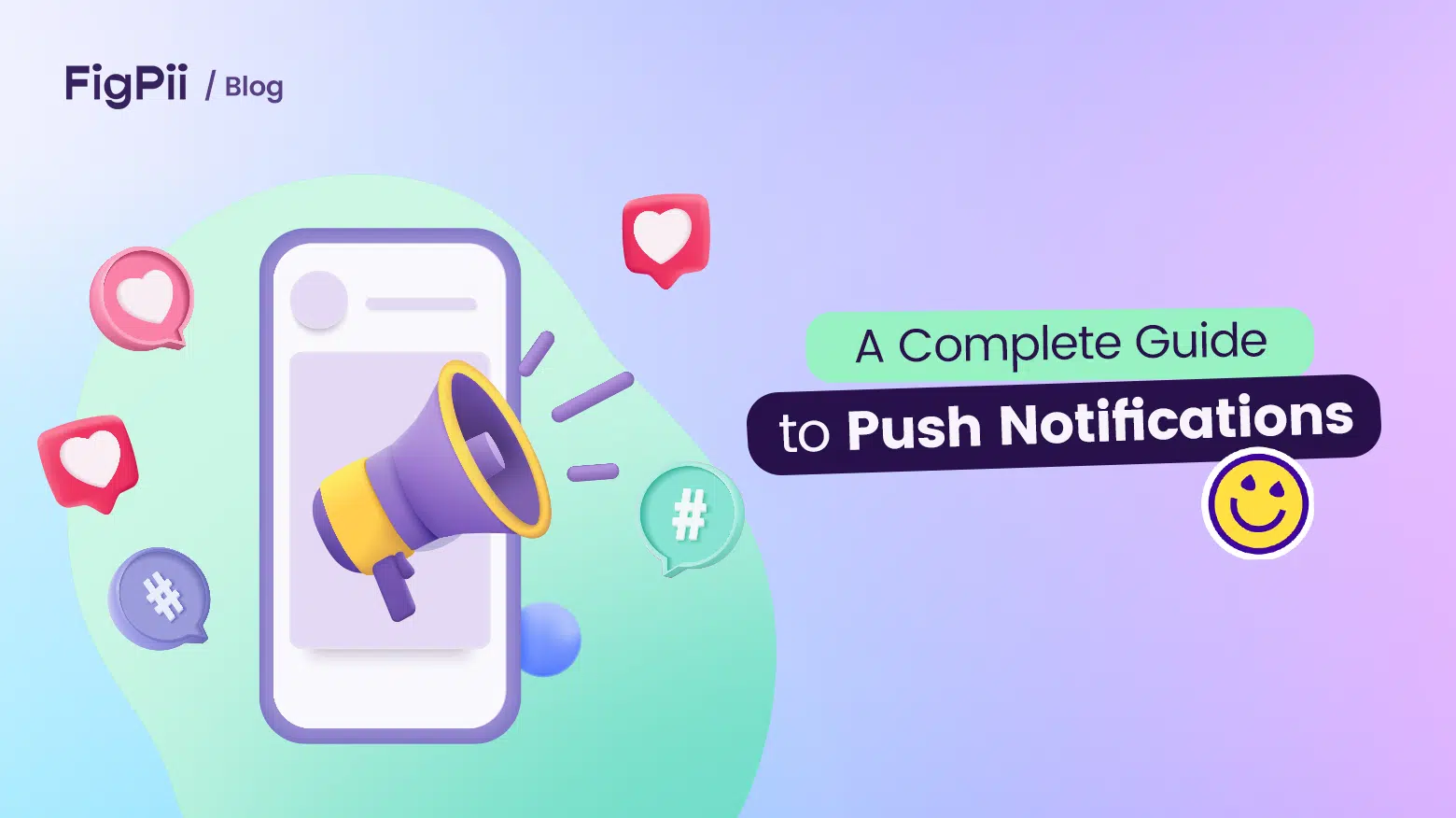Imagine having the power to reach out and captivate your audience at the perfect moment, delivering irresistible offers and personalized messages directly to their fingertips.
Welcome to the world of push notifications. Push notifications, those brief and impactful alerts on users’ devices, have become integral to our digital lives, spanning mobile apps, websites, and even smart devices.
From notifying users about exclusive offers and updates to reminding them of abandoned carts or providing real-time information, push notifications have proven to be a dynamic and effective channel for driving engagement, increasing conversions, and fostering brand loyalty.
Whether you’re a marketer, app developer, or entrepreneur, understanding the art of crafting compelling push notifications is the key to unlocking the full potential of this communication channel.
In this complete guide to push notifications, we’ll unravel the secrets behind their success, explore best practices, and reveal strategies that will help you create push notifications that truly shine.
What are Push Notifications, and How Do They Work?
Push notifications are a great way to get your app in front of users who have already downloaded it. You can use push notifications to send out specific news, alerts, and updates or offer discounts or coupons.
But what are push notifications? And how do they work? Let’s take a look at the basics.
Push notifications send messages from an application to a device, even when the application is not open. Brands can use them to alert users of new content, updates, new offers, and other information they may find relevant.
For example, here’s how Boxed uses push notifications to communicate a limited-time offer for Cyber Monday.
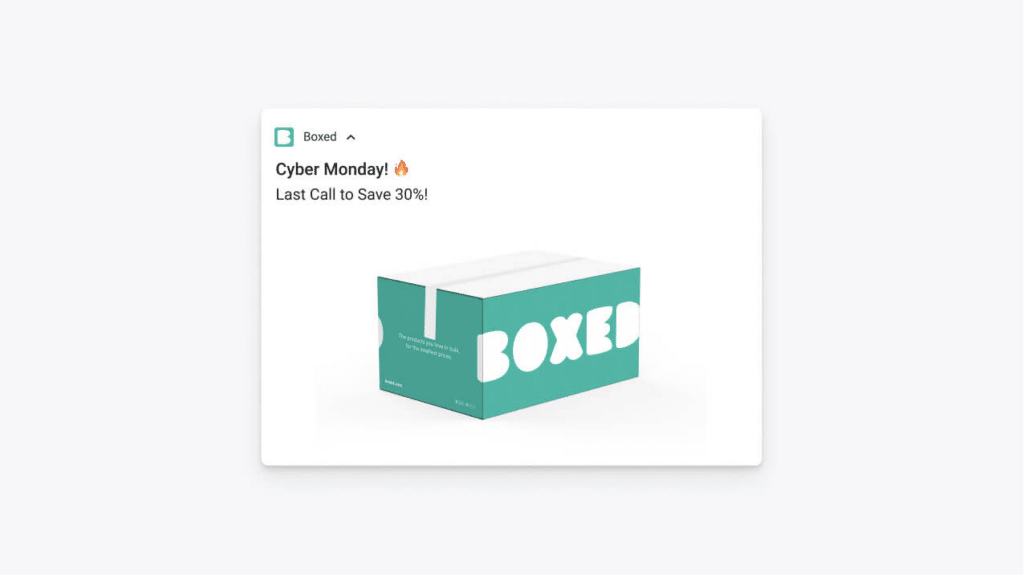
(Source)
Push notifications are often displayed as alerts on mobile devices but can also be displayed as pop-up windows or sounds.
An application server sends push notifications to a device through a provider (like Google Cloud Messaging). The provider then delivers the message to the operating system on the device. This allows developers to send messages without having direct access to the user’s phone or tablet.
Types of Push Notifications
You’ll usually see four main types of push notifications:
- Web push notifications: Web push notifications will appear on the user’s desktop or mobile browser when they visit a website that supports them. The user has to grant permission to receive these notifications. You can use them to send news, updates, offers, or reminders.
- Desktop push notifications: These notifications appear on the user’s desktop when a software application that supports them is installed. The user must install the application and be permitted to receive these notifications. You can use them to send alerts, messages, updates, or reminders.
- Mobile app push notifications: Mobile push notifications appear on the user’s mobile device when a mobile app that supports them is installed. The user has to install the app and give permission to receive these notifications. You can use them to send news, updates, offers, reminders, or personalized content.
- Push notifications for wearables: These notifications appear on the user’s wearable device – like a smartwatch or a fitness tracker.
Strategies for Push Notification Campaigns
There are many ways push notification campaigns can help your business. Some common types include:
1. Onboarding and welcome notifications
Welcome and onboarding push notifications are a great way to introduce your app to new users.
You can use these messages to:
- Welcome new users
- Inform them about the app’s features and services
- Guide them through their first experience with the product
Onboarding push notifications are usually sent once a user has downloaded an app or signed up for an account, but not immediately after.
Instead, you’ll want to wait until a user is ready for their first experience with your product — when they’ve had time to familiarize themselves with the interface and understand how it works.
Depending on your product’s complexity, this can take anywhere from 30 minutes to several hours.
2. Introducing a new product or feature
This is the most common type of push notification campaign.
Many brands use push notifications to announce new products or live features on your website. This can be an excellent way to get users to try out your product and convert them into customers.
This is typically done by sending promotional messages about the new product or feature for a specified period (e.g., two weeks).
Here’s an example of a brand announcing its new collection with special prices:

3. Promotional offers and discounts
Promotional push notifications are a great way to get your audience to take action. This type of campaign is ideal for offering discounts, free shipping, or special promotions.
Here’s an example of a product promotion discount from NaturAll Club, a brand that offers clean haircare and beauty products.
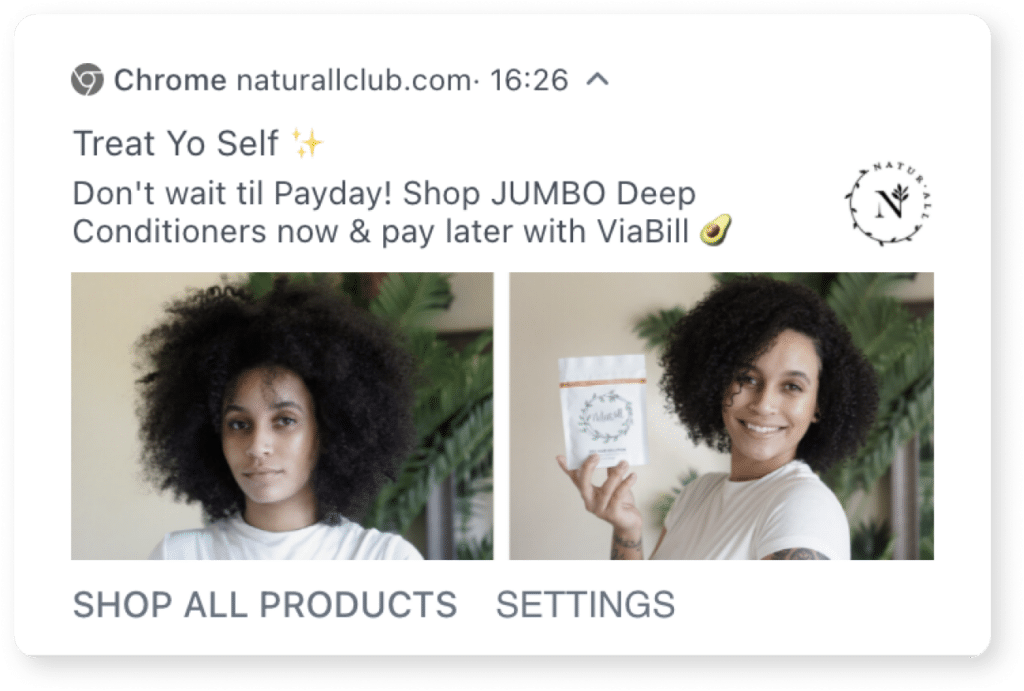
(Source)
However, ensure your offer is compelling enough so people will click on it instead of ignoring it.
4. Personalized recommendations and reminders
Push notifications that offer personalized recommendations based on the user’s purchase history, location, or browsing behavior are an effective way to show them products they might like.
For instance, here’s an example of a personalized and geo-targeted recommendation notification from Instakart:

(Source)
You can also use this campaign to encourage users to return to the app after being inactive for a while.
Reminders are another type of push notification campaign that aims to get users back into your app by sending them notifications about products they’ve previously purchased or interacted with in some other way.
5. Abandoned cart notifications
This type of campaign is a great way to increase your sales and revenue. You can send notifications to users who have abandoned their carts and encourage them to complete their purchases.
Here’s an example: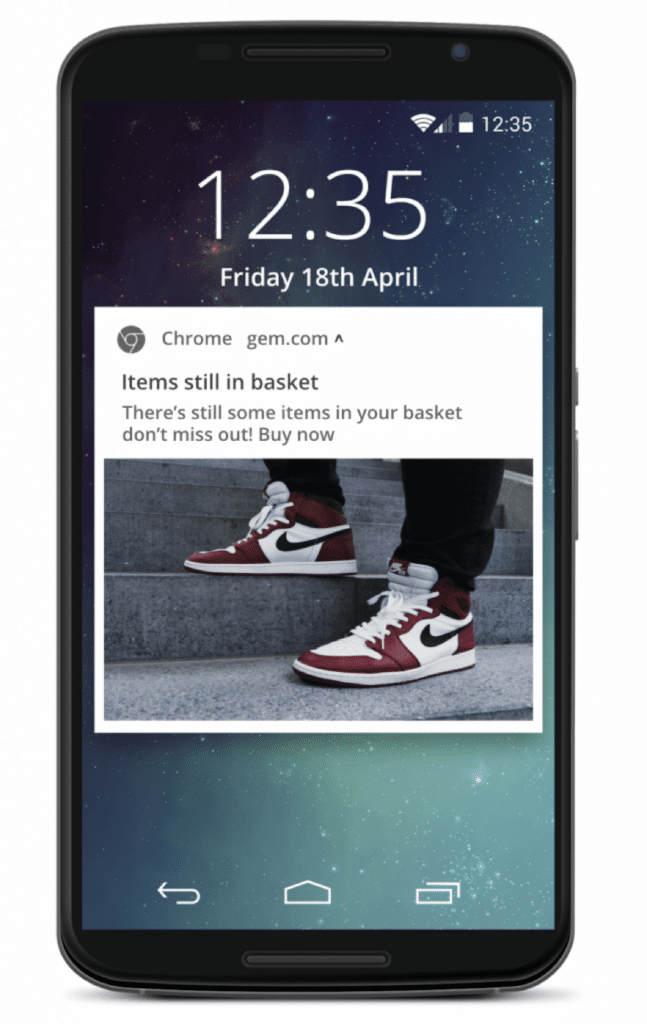
(Source)
Pro Tip: Offer some incentives and discounts to customers who abandon their carts. This strategy helps you to recover lost sales and bring more revenue to your business.
Best Practices for Effective Push Notifications
1. Understanding the target audience and their preferences
To maximize your push notifications campaign, you should know your target audience and tailor your message accordingly. How will you send them something they want to read otherwise?
There are multiple ways to discover your target audience and their preferences.
First and foremost, leverage Google Analytics to understand what your users want and how they interact with your app.
In addition, here are some specific tactics you can use to understand your target audience:
Demographic Analysis:
Demographic analysis helps you gain insights into the demographic characteristics of your user base, like age, gender, location, and language preferences.
This information allows you to create relevant and relatable notifications to specific audience segments.
For example, a fitness app may send different workout suggestions based on the user’s age and fitness goals.
Behavioral Tracking:
Track user behavior within your app to understand their preferences and habits. While at it, monitor user actions like app usage patterns, purchases, or content consumption.
This data can help you personalize notifications based on their interests and previous interactions.
For instance, an e-commerce app may send notifications about similar products or promotions based on a user’s previous purchases.
User Surveys and Feedback:
Engage with your users through surveys or customer feedback to gather direct insights into their preferences.
Ask them about the type of content they would like to receive or their preferred notification frequency. This feedback can guide you in delivering notifications that align with their expectations.
2. Crafting compelling and concise messages
A good push notification strategy includes crafting concise messages to boost user engagement.
After all, users don’t want to read long messages on their phone screens.
Statistics also suggest that on iOS, messages with 24 characters or less perform the best.
Look at this push notification from Lowbrow Customs, a seller of classic and modern motorcycle parts, for example: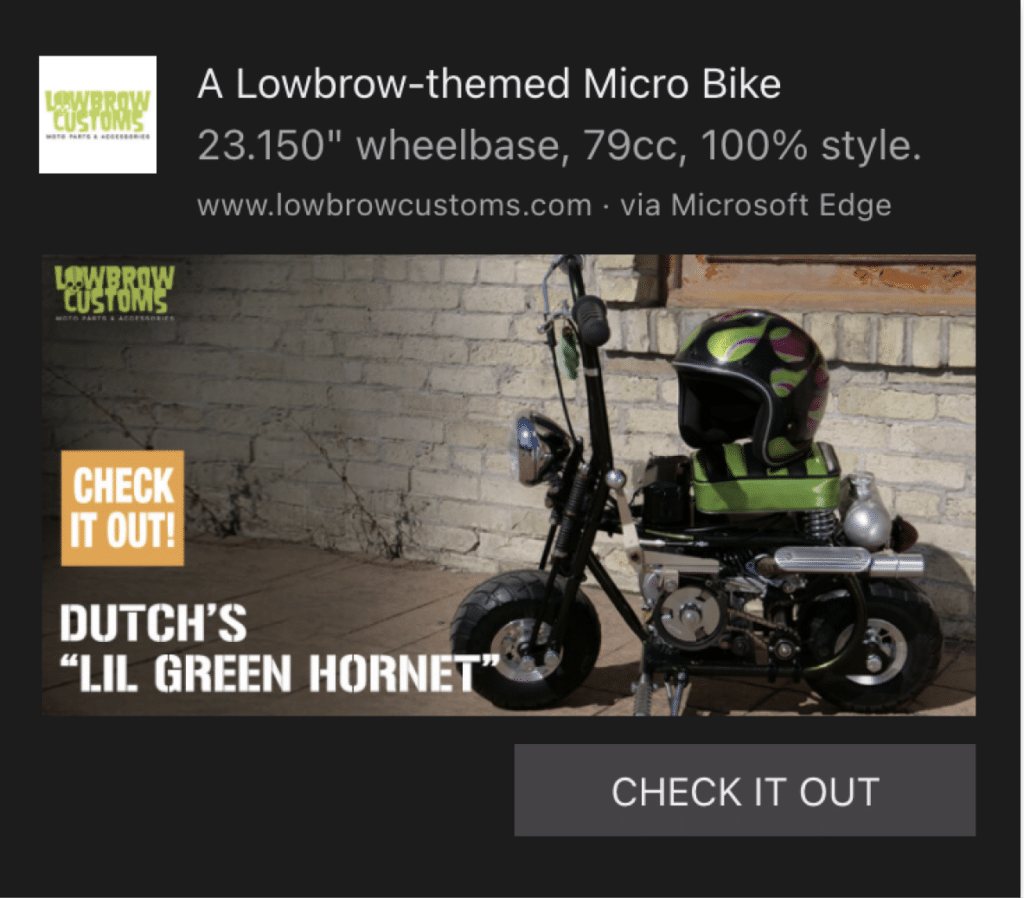
(Source)
The title and message are concise, conveying their message immediately. To top it off, they use a hero image to showcase the product.
The result? This concise push notification messaging earned them a 385x return on investment.
It’s clear that a short message is enough to quickly catch your audience’s attention and motivate them to click – given that it’s engaging and resonates with them.
But how do you create concise yet compelling push notifications? Here are some tips:
- Don’t send push notifications just for the sake of awareness. Give your users a reason to engage with your app by offering them something relevant, useful, or exclusive. For example, you can send them a special deal, a timely update, or a personalized recommendation based on their behavior.
- The title of your push notification should grab the user’s attention and make them curious about what’s inside. To spark interest, you can use questions, emojis, power words, or humor.
- Use a friendly and informal tone that reflects your brand personality and resonates with your target audience.
3. Personalize your push notifications
The first and most obvious way to personalize your push notifications is by using data in your database. This can be anything from customer names to previous purchases to their shopping cart contents.
However, the advertising and marketing world is more advanced than ever.
You can’t expect to send the same message to all people who open your app and get great results.
You have to use Dynamic Personalization to maximize your push notification marketing efforts. You can do this by sending different messages to different groups of people based on specific criteria (e.g., location, purchase history).
This is an excellent way to send targeted messages relevant to users’ needs and interests.
For example, if you want to send promotions to customers who live in New York City, customize your message based on their location.
If you’re running a sale on a popular product in California, target people in that state with an offer they’ll be more likely to respond to.
For example, Ticketmaster used geo-targeting and assessed user histories – resulting in higher conversion rates.

(Source)
How did they achieve this? They determined what events people liked attending and segmented their target list. This allowed them to send more personalized offers to specific audiences.
In addition, you can also personalize according to the time and day of the week.
You might want to send different messages at different times of day or week – or even change your messaging based on whether it’s morning or evening when someone opens your app.
For example, if someone opens up your app first thing in the morning, they may be looking for information about specific items and offers; later in the day, they may have more time and be open to other messages like coupons or news updates from your brand.
4. Incorporate relevant call-to-actions
You’ve crafted a beautiful push notification. Now, it’s time to make it interactive.
The most basic form of interactivity is a call-to-action (CTA). A CTA can be as simple as a button that allows users to take action on your app or website, like “Download Now!” or “Sign Up.”
If your content is exciting and relevant, consumers will want to engage with it. That’s why the best CTAs focus on actions that will lead to users performing the desired behavior you want them to perform.
For example, this shopping app’s push notification promotes a new bracelet sale with the CTA “Shop Now.”

(Source)
5. Timing and frequency considerations
Push notifications also help you re-engage users and keep them returning to your app. But since they generally go out randomly, they can be a little jarring if they show up while you’re in the middle of something else.
This can lead to users opting out of receiving notifications altogether, which is bad for you.
To ensure your push notifications are well received, consider the following:
Timing: When should you send out push notifications?
Ask yourself, ” What’s the goal of this message? Is it to generate awareness? Or perhaps drive sales or signups? Once you identify your goal, you can begin thinking about how best to accomplish it.
Another important consideration is “Frequency:” How often should you send push notifications?
Pro Tip: Only send a few notifications at a time. Spamming your audience with too many messages will make them ignore future notifications from your app or website. Instead, try sending an occasional nudge every few days or weeks at most unless you give attractive discounts and incentives.
For example, Domino’s mobile app uses push notifications to deliver enticing discounts to users.
If you open their app and exit it without placing an order, you’ll receive two push notifications alluding to rewards and reminding you to complete the order.

And if this doesn’t work, you’ll receive another well-timed series of push notifications offering increasing discounts to encourage you to purchase.

So, if their users didn’t place the order after the initial notification, they’ll be more likely to get encouraged by these extra discounts.
6. A/B testing for optimization
A/B testing is a great way to improve your app’s conversion rates.
The principle is simple: you send two variants of the same push notification to different segments of users and compare the results.
For example, you can use A/B testing to determine which text or color performs best.
You’ll get insights into which elements make your push notifications more effective so that you can improve them for all users.
To help you avoid technical hassle, there are A/B testing tools available to make the process easier.
7. Consider localization and language preferences
Naturally, your push notifications need to be relevant and valuable to users. One way to do this is by localizing them based on language and localization preferences.
Remember that language preference is only one component of a broader localization strategy.
Consider the user’s location and time zone when planning your push notification campaign.
Location-based notifications are handy if you want to inform users about nearby events or provide personalized recommendations based on their location (for example, if they are looking for restaurants in the area).
For example, sweaters on sale in the winter push notification. You can’t send it to people in countries with summers.
(Source)
Wrapping It Up: Your Turn to Unleash the Push Notification Magic!
Sending push notifications that pack a punch is about understanding your audience, personalizing your messages, and perfecting the timing. Remember Domino’s Pizza? They mastered the art of offering mouthwatering discounts at just the right moment.
But it doesn’t stop there. As you embark on your push notification adventure, keep an eye on user preferences, comply with privacy regulations, and continuously refine your approach.
And the future holds even more excitement! Imagine push notifications that get smarter with machine learning or seamlessly integrate with emerging technologies. The possibilities are as endless as the toppings on your favorite pizza.
Now armed with the knowledge and strategies shared in this guide, it’s time to unleash the power of push notifications and forge meaningful connections with your audience. So craft captivating messages, inspire action, and make a lasting impact with your push notifications. The possibilities are boundless, and your audience awaits.
Let user data be your guiding star, and don’t shy away from the occasional A/B test to fine-tune your notifications.

